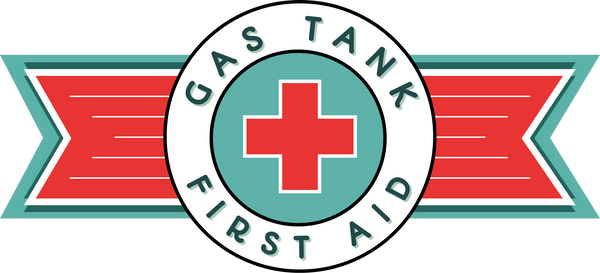Here we will show you our process of installing a permanent epoxy liner inside of an older vintage automotive gas tank. We will go over the complete process step by step so you have a better understanding of what's involved before making a purchase as well as answering any questions or concerns you may have. Let's begin.
First, Before unpacking the gas tank. We begin by inspecting the shipping box. Checking for any obvious signs of shipping damage that may have occurred. We will take pictures of the box as it was received before opening it. Next, we will upack the gas tank. Thoroughly look over the gas tank and inspect its condition. Identifying holes, rust, damage to the tank inside and outside. Reviewing the paperwork and order information for the gas tank we received online. We will notify the customer that we have received the gas tank and the condition we received it in. If any shipping damage has occurred. We can assist the customer with pictures to help file their claim with the shipping carrier.
Next, we are going to take pictures of the gas tank before any work is performed. Once pictures are taken
Since this motorcycle gas tank has a paint job that needs to be preserved. We are going to wrap the tank in plastic stretch wrap. Before we begin wrapping the tank. We apply Kreem Tank Mask paint protection. Specifically designed to seal off and protect your paint job. After we apply a few coats of Kreem Tank Mask. We wrap the tank in plastic stretch wrap. You can do too much of this and prefer at least 15 or more layers. Preserving the gas tanks paint job is the most important detail for us.
Next, we will prepare the gas tank to be mounted onto the tumbling machine. Because the gas tank will be filled with fluid and tumbling media. We must plug off any openings and seal the gas tank. We have a lot of various caps, plugs and rubber block off plates on hand to work with.
With the gas tank mounted onto our tumbling machine. We begin by partially filling the gas tank with 1 gallon of white vinegar and tumbling media. Having tested several different commercial rust removers. Surprisingly white vinegar works the best, is safe to handle and won't hurt paint making it great for painted motorcycle gas tanks. As for our media. Having experimented with different media. What we found to work best is a blend of stainless steel chips combined with 10 grit silicon carbide. With the media and vinegar loaded inside the tank. We seal off the opening and set the tumbling machine to turn for one hour.
After turning for one hour. We remove the gas tank from the tumbler. Empty the tank out. Rinse it clean with tap water. Inspect the inside of the tank. Even with a badly rusted gas tank. The first round of tumbling does a really great job of removing most of the rust. It generally takes 2-3 rounds to get the gas tank to where we are satisfied with it. We mount the tank back onto the tumbler. Load the tank with 1 gallon of vinegar and media for round two. Set the tumbling machine for 60 minutes.
After the second hour of tumbling is complete. We remove the gas tank from the tumbling machine. Empty everything out. Rinse the tank clean with water. Inspect the inside. Determine if the tank needs to turn for a third time with vinegar or not. In this case the tank was very clean inside. Now it's time to neutralize the acidity of the vinegar. Best way to do this is with baking soda and water. We load the tank back onto the tumbling machine. Add one gallon of deionized water, baking soda and our media blend. Set the timer on the machine for 20 minutes.
After turning for 20 minutes. We remove the gas tank. Empty everything out. Rinse the gas tank out. Inspect the inside making sure everything is rinsed out. Now it's time to apply a rust neutralizer. Even though the inside of the gas tank is visibly free of rust. Using a rust neutralizer will penetrate deep into any gas tank seams, welds, threads etc. Dehydrating and neutralizing any rust our media was not able to contact and scrub away. We add approximately 24 ounces of Rust Inhibitor #6 along with our media blend. Set the tumbling machine for 20 minutes.
After turning for 20 minutes. We remove the gas tank. Empty everything out. Rinse the gas tank out. Inspect the inside making sure everything is rinsed out. We then quickly blow the inside of the tank dry. Using a combination of compressed air followed by 15 minutes of warm air using a common household hair dryer. Our final and last tumbling session to prepare the inside surface for optimal liner adhesion will follow.
As we are going to do one tumbling session but this time dry, with a blend of drywall screws and 10 grit silicon carbide. This next step will not only remove the light film left behind by the rust neutralizer. It will provide us with the surface profile we need to better allow our epoxy liner to bond to the gas tank. This is a really key step in getting the liner to permanently bond to the inside of the gas tank. We mount the gas tank back onto the tumbling machine. Load the dry tumbling media into the gas tank. Set the timer for 10 minutes.
Once the dry tumbling session is completed. The gas tank is removed from the tumbling machine. Contents are emptied out. Gas tank is blown out using compressed air. Tank is inspected making sure the inside is free of any media. We add one quart of rubbing alcohol to the inside of the gas tank. Reinstall the tank block off plate. Rotate the tank around by hand so that the rubbing alcohol rinses all the surfaces inside the tank. Do this for 2-3 minutes. Remove the block off plate. Empty the tank out. Immediately blow the tank dry. This gas tank is now ready to have the liner installed.
Having tested different two part epoxies and many discussions with the chemical companies who make these epoxies for the Military and specifically for use with steel fuel tanks. The epoxy we are using is silver in color. Compatible with all types of fuels including racing fuels and ethanol. Its crosslink structure is extremely tough and has a high adhesion factor. Designed to protect metal surfaces from severe chemicals. Due to its chemical makeup. It is classified as a hazardous material and can only be shipped via LTL and purchased with a business license. You can not get a better epoxy to seal your gas tank with.
With the gas tank remounted to the tumbling machine. We mix the two part epoxy. Pour approximately one quart into the tank. Seal the tank. Set the tumbling machine to turn for 20 minutes at slower speed.
After turning for 20 minutes. We remove the tank. Drain out any excess sealer. Place the gas tank inside our curing oven for 1 hour. Temperature is set at approximately 110-120 degree's.
After being in our oven for one hour. Gas tank is removed and reinstalled on our tumbling machine for the 2nd coat. A total of three coats will be applied. This is what makes our gas tank liners so impressive. The use of multiple coats, high build and heated curing oven dramatically improve the properties of the epoxy. We allow the gas tank to fully cure in our shop for 48 hours before returning it back to the customer. Customers can immediately reinstall the gas tank and begin using it. Thanks for reading along. Let us know if you have any questions.

